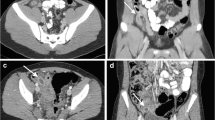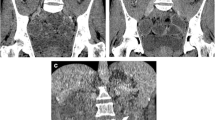Abstract
Purpose
To compare radiologists’ diagnostic performance and confidence, and subjective image quality between filtered back projection (FBP) and iterative reconstruction (IR) at 2-mSv appendiceal CT.
Methods
The institutional review board approved this retrospective study and waived the requirement for informed consent. We included 107 adolescents and young adults (age, 29.8 ± 8.5 years; 64 females) undergoing 2-mSv CT for suspected appendicitis. Appendicitis was pathologically confirmed in 42 patients. Seven readers with different experience levels independently reviewed the CT images reconstructed using FBP and IR (iDose4, Philips). They rated both the likelihood of appendicitis and subjective image quality on 5-point Likert scales. Diagnostic confidence was assessed using the likelihood of appendicitis, proportion of indeterminate interpretations, and 3-point normal appendix visualization score. We used receiver operating characteristic analyses, Wilcoxon’s signed-rank tests, and McNemar’s tests.
Results
The pooled area under the receiver operating characteristic curve (AUC) was 0.96 for both FBP and IR (95% CI for the difference, −0.02, 0.02; P = 0.73). The AUC difference was not significant in any of the individual readers (P ≥ 0.21). For the majority of the readers, the diagnostic confidence was not significantly different between the two reconstruction methods. Subjective image quality tended to be higher with IR for all readers (P ≤ 0.70), showing significant differences for four readers (P ≤ 0.040).
Conclusion
When diagnosing appendicitis at 2-mSv CT in adolescents and young adults, FBP and IR were comparable in radiologists’ diagnostic performance and confidence while IR exhibited higher subjective image quality than FBP.




Similar content being viewed by others
References
Drake FT, Florence MG, Johnson MG, et al. (2012) Progress in the diagnosis of appendicitis: a report from Washington State’s Surgical Care and Outcomes Assessment Program. Ann Surg 256:586–594
Raja AS, Wright C, Sodickson AD, et al. (2010) Negative appendectomy rate in the era of CT: an 18-year perspective. Radiology 256:460–465
Coursey CA, Nelson RC, Patel MB, et al. (2010) Making the diagnosis of acute appendicitis: do more preoperative CT scans mean fewer negative appendectomies? A 10-year study. Radiology 254:460–468
Park JH (2014) Diagnostic imaging utilization in cases of acute appendicitis: multi-center experience. J Korean Med Sci 29:1308–1316
Addiss DG, Shaffer N, Fowler BS, Tauxe RV (1990) The epidemiology of appendicitis and appendectomy in the United States. Am J Epidemiol 132:910–925
Rhea JT, Halpern EF, Ptak T, et al. (2005) The status of appendiceal CT in an urban medical center 5 years after its introduction: experience with 753 patients. Am J Roentgenol 184:1802–1808
Berrington de Gonzalez A, Mahesh M, Kim KP, et al. (2009) Projected cancer risks from computed tomographic scans performed in the United States in 2007. Arch Intern Med 169:2071–2077
Brenner DJ, Hall EJ (2007) Computed tomography-an increasing source of radiation exposure. N Engl J Med 357:2277–2284
Smith-Bindman R, Lipson J, Marcus R, et al. (2009) Radiation dose associated with common computed tomography examinations and the associated lifetime attributable risk of cancer. Arch Intern Med 169:2078–2086
Pearce MS, Salotti JA, Little MP, et al. (2012) Radiation exposure from CT scans in childhood and subsequent risk of leukaemia and brain tumours: a retrospective cohort study. Lancet 380:499–505
Berlin L (2011) To order or not to order a CT examination because of radiation exposure: that is the question. Am J Roentgenol 196:W216
Kim SY, Lee KH, Kim K, et al. (2011) Acute appendicitis in young adults: low- versus standard-radiation-dose contrast-enhanced abdominal CT for diagnosis. Radiology 260:437–445
Seo H, Lee KH, Kim HJ, et al. (2009) Diagnosis of acute appendicitis with sliding slab ray-sum interpretation of low-dose unenhanced CT and standard-dose i.v. contrast-enhanced CT scans. Am J Roentgenol 193:96–105
Kim K, Kim YH, Kim SY, et al. (2012) Low-dose abdominal CT for evaluating suspected appendicitis. N Engl J Med 366:1596–1605
Keyzer C, Tack D, de Maertelaer V, et al. (2004) Acute appendicitis: comparison of low-dose and standard-dose unenhanced multi-detector row CT. Radiology 232:164–172
Kulkarni NM, Uppot RN, Eisner BH, Sahani DV (2012) Radiation dose reduction at multidetector CT with adaptive statistical iterative reconstruction for evaluation of urolithiasis: how low can we go? Radiology 265:158–166
Mitsumori LM, Shuman WP, Busey JM, Kolokythas O, Koprowicz KM (2012) Adaptive statistical iterative reconstruction versus filtered back projection in the same patient: 64 channel liver CT image quality and patient radiation dose. Eur Radiol 22:138–143
Willemink MJ, Leiner T, de Jong PA, et al. (2013) Iterative reconstruction techniques for computed tomography part 2: initial results in dose reduction and image quality. Eur Radiol 23:1632–1642
Ehman EC, Yu L, Manduca A, et al. (2014) Methods for clinical evaluation of noise reduction techniques in abdominopelvic CT. Radiographics 34:849–862
Goenka AH, Herts BR, Obuchowski NA, et al. (2014) Effect of reduced radiation exposure and iterative reconstruction on detection of low-contrast low-attenuation lesions in an anthropomorphic liver phantom: an 18-reader study. Radiology 272:154–163
Pickhardt PJ, Lubner MG, Kim DH, et al. (2012) Abdominal CT with model-based iterative reconstruction (MBIR): initial results of a prospective trial comparing ultralow-dose with standard-dose imaging. Am J Roentgenol 199:1266–1274
Schindera ST, Odedra D, Raza SA, et al. (2013) Iterative reconstruction algorithm for CT: can radiation dose be decreased while low-contrast detectability is preserved? Radiology 269:511–518
Padole A, Ali Khawaja RD, Kalra MK, Singh S (2015) CT radiation dose and iterative reconstruction techniques. Am J Roentgenol 204:W384–W392
Ahn S, LOCAT Group (2014) LOCAT (low-dose computed tomography for appendicitis trial) comparing clinical outcomes following low- vs standard-dose computed tomography as the first-line imaging test in adolescents and young adults with suspected acute appendicitis: study protocol for a randomized controlled trial. Trials 15:28
Deak PD, Smal Y, Kalender WA (2010) Multisection CT protocols: sex- and age-specific conversion factors used to determine effective dose from dose-length product. Radiology 257:158–166
Soni NK, Cohn NA (2009) Strategies to reduce radiation dose in Philips multidetector computed tomography scanners. In: Mahesh M (ed) MDCT physics: the basics—technology, image quality and radiation dose, 1st edn. Philadelphia: Lippincott Williams & Wilkins, pp 125–130
Scibelli A (2013) iDose4 iterative reconstruction technique. Philips Healthcare Whitepaper. https://www.healthcare.philips.com/pwc_hc/main/shared/Assets/Documents/ct/idose_white_paper_452296267841.pdf. Accessed 12 Feb 2013
Lee KH, Lee HJ, Kim JH, et al. (2005) Managing the CT data explosion: initial experiences of archiving volumetric datasets in a mini-PACS. J Digit Imaging 18:188–195
Lee YJ, Kim B, Ko Y, et al. (2015) Low-dose (2-mSv) CT in adolescents and young adults with suspected appendicitis: advantages of additional review of thin sections using multiplanar sliding-slab averaging technique. Am J Roentgenol 205:W485–W491
Joo SM, Lee KH, Kim YH, et al. (2009) Detection of the normal appendix with low-dose unenhanced CT: use of the sliding slab averaging technique. Radiology 251:780–787
Menzel H, Schibilla H, Teunen D (2000) European guidelines on quality criteria for computed tomography. EUR 16262 EN, European Commission, Luxembourg
Rosai J, Ackerman LV (2011) Appendix. In: Rosai J (ed) Rosai and Ackerman’s surgical pathology, 10th edn. St. Louis: Mosby, pp 714–718
Fenoglio-Preiser CM, Noffsinger AE, Stemmermann GN, Lantz PE, Isaacson PG (2008) Nonneoplastic diseases of the appendix. In: Fenoglio-Preiser CM (ed) Gastrointestinal pathology, 3rd edn. Philadelphia: Lippincott Williams & Wilkins, pp 504–505
Newcombe RG (1998) Improved confidence intervals for the difference between binomial proportions based on paired data. Stat Med 17:2635–2650
Gallas BD (2006) One-shot estimate of MRMC variance: AUC. Acad Radiol 13:353–362
Obuchowski NA, Gallas BD, Hillis SL (2012) Multi-reader ROC studies with split-plot designs: a comparison of statistical methods. Acad Radiol 19:1508–1517
Daly CP, Cohan RH, Francis IR, et al. (2005) Incidence of acute appendicitis in patients with equivocal CT findings. Am J Roentgenol 184:1813–1820
Lee H, Kim B, Kim KJ, et al. (2011) Introduction of heat map to fidelity assessment of compressed CT images. Med Phys 38:4667–4671
Alvarado A (1986) A practical score for the early diagnosis of acute appendicitis. Ann Emerg Med 15:557–564
Andersson M, Andersson RE (2008) The appendicitis inflammatory response score: a tool for the diagnosis of acute appendicitis that outperforms the Alvarado score. World J Surg 32:1843–1849
Didier RA, Vajtai PL, Hopkins KL (2015) Iterative reconstruction technique with reduced volume CT dose index: diagnostic accuracy in pediatric acute appendicitis. Pediatr Radiol 45:181–187
Kim SH, Yoon JH, Lee JH, et al. (2014) Low-dose CT for patients with clinically suspected acute appendicitis: optimal strength of sinogram affirmed iterative reconstruction for image quality and diagnostic performance. Acta Radiol. doi:10.1177/0284185114542297
Callahan MJ, Kleinman PL, Strauss KJ, et al. (2015) Pediatric CT dose reduction for suspected appendicitis: a practice quality improvement project using artificial Gaussian noise–part 1, computer simulations. Am J Roentgenol 204:W86–W94
Swanick CW, Gaca AM, Hollingsworth CL, et al. (2013) Comparison of conventional and simulated reduced-tube current MDCT for evaluation of suspected appendicitis in the pediatric population. Am J Roentgenol 201:651–658
Ahn S, Park SH, Lee KH (2013) How to demonstrate similarity by using noninferiority and equivalence statistical testing in radiology research. Radiology 267:328–338
Acknowledgments
The authors are indebted to J. Patrick Barron, Professor Emeritus, Tokyo Medical University and Adjunct Professor, Seoul National University Bundang Hospital for his pro bono editing of this manuscript.
Funding
This research was supported by grants of the Korea Health Technology R&D Project through the Korea Health Industry Development Institute (KHIDI), funded by the Ministry of Health & Welfare, Republic of Korea (No. HI13C0004), and Basic Science Research Program through the National Research Foundation of Korea (NRF) funded by the Ministry of Education, Science and Technology (NRF-2013R1A1A3006706). And this research was partly supported by the Seoul National University Bundang Hospital Research Fund (No. 13-2014-001).
Author information
Authors and Affiliations
Corresponding author
Ethics declarations
Conflict of interest
Bohyoung Kim has received research grants from the Ministry of Education, Science and Technology (NRF-2013R1A1A3006706) and the Seoul National University Bundang Hospital (No. 13-2014-001). Kyoung Ho Lee has received research grants from the Ministry of Health & Welfare, Republic of Korea (No. HI13C0004).
Additional information
For LOCAT Group.
Electronic supplementary material
Below is the link to the electronic supplementary material.
Rights and permissions
About this article
Cite this article
Park, J.H., Kim, B., Kim, M.S. et al. Comparison of filtered back projection and iterative reconstruction in diagnosing appendicitis at 2-mSv CT. Abdom Radiol 41, 1227–1236 (2016). https://doi.org/10.1007/s00261-015-0632-4
Published:
Issue Date:
DOI: https://doi.org/10.1007/s00261-015-0632-4




